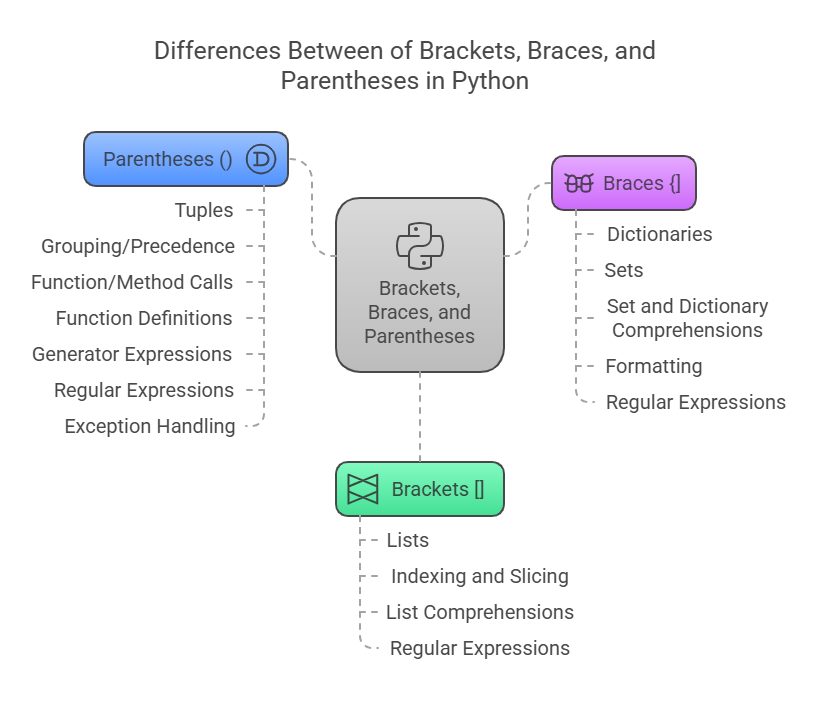Disses About Brackets, Braces and Parentheses in Python
The distinct functions of brackets [], braces, and brackets () in Python are mostly associated with handling regular expressions, constructing data structures, and regulating program flow. Python, in contrast to certain other programming languages, defines code blocks largely with indentation rather than curly brackets.

Brackets
[] Generally speaking, ordered, changeable sequences are linked to brackets [].
Lists:
Lists are mutable data types that are created with brackets. defines a list, for instance. [] is used to create an empty list.
Indexing and Slicing:
Brackets can index or slice lists, tuples, and strings by supplying an integer offset. Even though the value enclosed in parenthesis is a key rather than an offset, this also holds true for accessing dictionary values by their key.
List Comprehensions: In list comprehension syntax, brackets are used to build a new list from an existing iterable.
Regular Expressions:
Square brackets [] in regular expressions define a character set (or character class) that corresponds to any single character included in the brackets. ‘a’, ‘b’, or ‘c’ are matched by [abc], while ‘a-z’ matches any lowerletter.
Characters that are typically special (such as. or *) are handled as literals inside character sets and do not require escape. The set is negated by a caret ^ as the first character enclosed in brackets ([^…]), matching any character that is not in the set.
Braces
{} For unordered collections, use braces {}.
Dictionaries:
Dictionaries, which store information as key-value pairs, are defined with braces. Dictionaries do not employ numerical indexing; instead, they use keys for access. Commas are used to separate key-value pairs, and colons (:) are used to separate the key and value within a pair. An empty dictionary is produced by an empty set of braces {}.
Sets:
Sets are collections of distinct, unordered elements that are defined with braces. Sets do not support indexing or slicing since they are not ordered. Since {} creates an empty dictionary, you can use the set() function to construct an empty set.
Set and Dictionary Comprehensions: Additionally, the syntax for dictionary and set comprehensions uses braces.
Formatting: Format strings, including f-strings, use braces {} as placeholders to embed values.
Regular Expressions:
Curly brackets {} in regular expressions indicate how many times the previous character or group must appear. Whereas {m, n} matches between m and n occurrences, {n} matches exactly n occurrences.
Parentheses
() Parentheses () serve a variety of purposes, such as invoking functions, constructing immutable sequences, and regulating evaluation order.
Tuples:
Tuples are ordered, unchangeable sequences that are created with brackets. Although brackets are frequently used to contain tuples, the comma is actually the main grammatical component that forms a tuple; in situations when it is not unclear, brackets may be removed. Similar to lists and strings, tuples can be sliced and indexed.
Grouping/Precedence:
The order of evaluation is made clear by using brackets to group expressions and override the operator precedence that is set by default. This eliminates ambiguity and makes the text easier to understand.
Function/Method Calls:
Functions and methods are called with brackets. Since function and function() have different meanings, they are necessary even if the function doesn’t accept any arguments.
Function Definitions: In function definitions, the arguments that the function accepts are included in parenthesis.
Generator Expressions: Generator expressions, which resemble list comprehensions but produce results on demand, employ brackets.
Regular Expressions:
Parentheses () are used in regular expressions to “capture” or remember the matched substring and to group portions of a pattern together. They can be escaped to match literal brackets by using ( and ).
Exception Handling: In unless clauses, brackets can be used to capture several distinct exceptions with a single handler.
